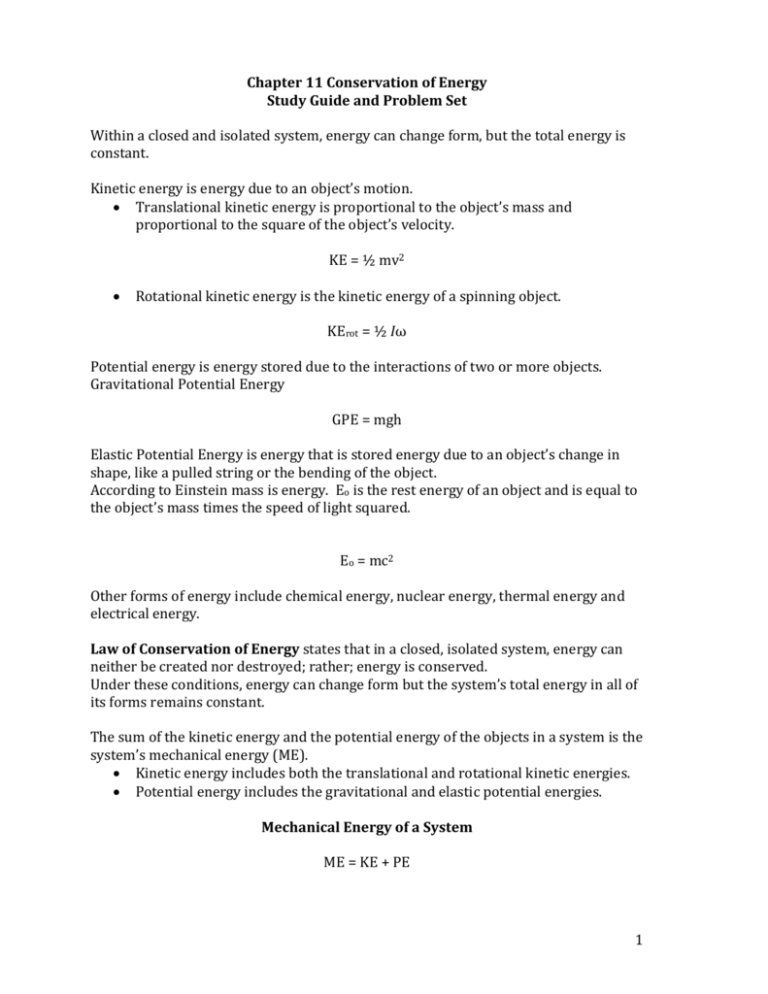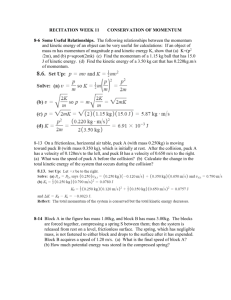Chapter 11 Conservation of Energy Review and Problem Set
advertisement

Chapter 11 Conservation of Energy Study Guide and Problem Set Within a closed and isolated system, energy can change form, but the total energy is constant. Kinetic energy is energy due to an object’s motion. Translational kinetic energy is proportional to the object’s mass and proportional to the square of the object’s velocity. KE = ½ mv2 Rotational kinetic energy is the kinetic energy of a spinning object. KErot = ½ Iω Potential energy is energy stored due to the interactions of two or more objects. Gravitational Potential Energy GPE = mgh Elastic Potential Energy is energy that is stored energy due to an object’s change in shape, like a pulled string or the bending of the object. According to Einstein mass is energy. Eo is the rest energy of an object and is equal to the object’s mass times the speed of light squared. Eo = mc2 Other forms of energy include chemical energy, nuclear energy, thermal energy and electrical energy. Law of Conservation of Energy states that in a closed, isolated system, energy can neither be created nor destroyed; rather; energy is conserved. Under these conditions, energy can change form but the system’s total energy in all of its forms remains constant. The sum of the kinetic energy and the potential energy of the objects in a system is the system’s mechanical energy (ME). Kinetic energy includes both the translational and rotational kinetic energies. Potential energy includes the gravitational and elastic potential energies. Mechanical Energy of a System ME = KE + PE 1 In a closed, isolated system where the only forms of energy are kinetic energy and potential energy, mechanical energy is conserved, that is, the mechanical energy before an event is the same as the mechanical energy after the event. KEi + PEi = KEf + PEf Collisions - Momentum is conserved in collisions if the external force is zero. If the system is isolated, then momentum and energy is conserved. However, the potential energy or thermal energy in the system may decrease, remain the same or increase. Therefore, you cannot predict whether kinetic energy is conserved. The type of collision in which the kinetic energy before and after the collision is the same is called elastic collision. The type of collision in which the kinetic energy after the collision is less than the kinetic energy before the collision is called an inelastic collision. Problem Set for Chapter 11 1. An 875.0 kg compact car speeds up from 22.0 m/s to 44.0 m/s. What are the initial and final kinetic energies of the car? How much work is done on the car to increase its speed? 2. A 2 kg wheel rolls down the road with a linear speed of 15 m/s. Find its translational and rotational kinetic energies? 3. If a 1.8 kg brick falls to the ground from a chimney that is 6.7 m high, what is the change in the potential energy of the brick-Earth system? 4. A 25.0 kg shell is shot from a cannon at Earth’s surface. The reference level is Earth’s surface. a. What is the shell-Earth system’s gravitational potential energy when the shell’s height is 425 m? b. What is the change in potential energy when the shell falls to a height of 225 m? 5. An experimental train with a mass of 2.5 x 104 kg was powered along 509 m of level track by a jet engine that produces a thrust of 5 x 105 N. a. Find the work done on the train by the jet engine. b. Find the change in kinetic energy. c. Find the final kinetic energy of the train if it started from rest. d. Find the final speed of the train. 2 6. A 2.00 x 103 kg car has a speed of 12.0 m/s when it hits a tree. The tree doesn’t move, and the car comes to rest. a. Find the change in kinetic energy of the car. b. Find the amount of work done by the tree on the car as the from of the car crashes into the tree. c. Find the magnitude of the force that pushed in the front of the car by 50.0 cm. 7. A 5.0 x 105 kg railroad car collides with a stationary railroad car of equal mass. After the collision, the two cars lock together and move off. a. Before the collision, the first railroad car was moving at 8.0 m/s. What was its momentum? b. What was the total momentum of the two cars after the collision? c. What were the kinetic energies of the two cars before and after the collision? 8. Olivia’s mass is 28 kg. She climbs the 4.8 m ladder of a slide and reaches a velocity of 3.2 m/s at the bottom of the slide. How much mechanical energy did friction transform to other forms? 9. A 0.80 kg cart tolls down a frictionless hill of height of 0.32 m. At the bottom of the hill, the cart rolls on a flat surface, which exerts a frictional force of 2.0 N on the cart. How far does the cart roll on the flat surface before it comes to a stop? 10. A worker picks up a 10.1 kg box from the floor and sets it on a 1.1 m high table. He slides the box 5.0 m along the table and them lowers it back to the floor. What are the changes in the box-Earth system’s energy, and how did the system’s total energy change? 3







